The update of chipsets and processors for the Intel LGA1200 platform this year attracted the attention of the broad masses of workers to memory overclocking, and to the modules themselves with an increased (but not extreme) frequency. Previously, after all, this was mainly entertainment for real enthusiasts – simply because Intel allowed it only with special “overclocker” chipsets. Of which there was always in the line … exactly one – and, of course, the most expensive. Accordingly, those were purchased most often paired with “overclocker” processors. Well, then everything that was possible was often overclocked – and the memory for the company. Buying an expensive motherboard paired with a “regular” Core i5/i7 (especially a Core i3) didn’t make much sense, and models based on conventional B- and H-series chipsets did not support memory overclocking, so the majority of buyers of systems based on Intel processors did not pay attention to the memory frequency. Moreover, the company has always been conservative about the “official” memory frequencies, not in too much of a hurry to increase them. Here, AMD has always kept abreast of the release of new DDR4 specifications, and even did not mind overclocking memory on boards with any chipsets – including even the “starter” A320.
Rocket Lake and the 500th line of chipsets have changed things a lot this year. By and large, life was even spoiled for enthusiasts – in the new processors, the memory controller became dual-mode (as in Ryzen), so, on the one hand, it became easier to overclock memory to high frequencies, and on the other hand, this is achieved in Gear2 mode, where delays are noticeable higher, so that the overall performance during “overclocking” may even decrease. But an interesting gift was made to mass users – now you can overclock memory on almost all boards. In the previous line, only the Z490 was traditionally suitable for this – in the new one, only the budget H510 is not suitable. At the same time, new boards may be of interest to those who choose the processor of the “tenth” and not the “eleventh” family. If only because some B460 will not allow you to switch to the “eleventh” later, but the B560 for a comparable price is completely. It is clear that 99% of boards are operated all their lives with the same processor that was originally installed. But another 1% of upgrade enthusiasts survived – and 9% of those who suggest its possibility at least potentially (well, let Core i3 now – but then I’ll buy Core i9 at a flea market for a penny). Plus, native support for USB3 Gen2 × 2 on many boards, plus they themselves are fresh – so if you have specific needs (such as a 2.5 Gb / s wired network or Wi-Fi 6 – it’s easier and often cheaper to look for a suitable one in the new collection). To which we also add memory overclocking – and the modest B560 starts to look better than even the H470, or even inexpensive models based on the Z490. Of course, different boards differ not only in chipsets – so it’s important not to forget other characteristics (first of all, the power supply system; especially if the “eleventh” series processor is planned at least in the future) – but this should always be done. And with regard to chipsets, their younger versions have now become no worse than the older ones for most buyers. In the latter , there are more , but this is already redundant for many. And the overclocking of processors remained the prerogative of the Z590 – but modern models are already so actively trying to “boost” that it is no longer necessary to help them with this. Here are the power consumption limits on a board with a “good” power supply and with a “good” cooler, as much as possible can be increased – but this also applies to the V560.
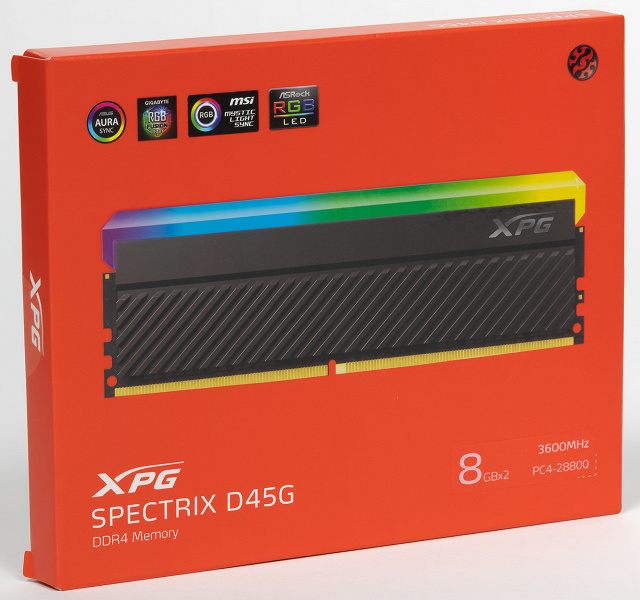
Naturally, memory manufacturers also reacted to such a change in concept. In particular, in May, Adata added Gammix D45 and Spectrix D45 RGB modules to the range of the XPG family (products for gamers and enthusiasts are traditionally produced under this brand). To a first approximation, they are the same. The only difference is that the first of the pleasant frills has only a simple aluminum heatsink, and the second also has a customizable backlight that is compatible with the main control systems such as Asus, MSI, Gigabyte and ASRock (but if you wish, you can also use the proprietary XPG utility to configure RGB sync). Both lines have modules of 8, 16 and 32 GB, and are sold both individually and in pairs. The main mode of operation is 3600 MHz CL 18-22-22 1.35 V, which is wired into the XMP 2.0 profile. Modules of 8 GB can also support a maximum frequency of 4133 MHz or even 4400 MHz – but for Rocket Lake, as mentioned above, this is not so necessary. At the same time, there is compatibility with JEDEC standards at the DDR4-2666 level, which can be useful mainly in “old” systems, where such (or lower) frequencies were often standard for processors, and it was impossible to increase them. This problem has now been mitigated.
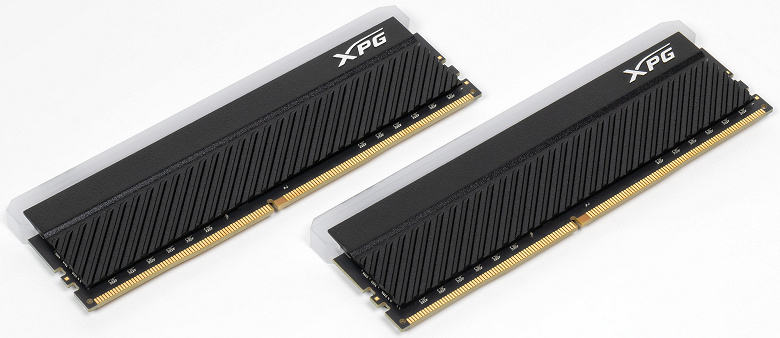
For a more detailed acquaintance, we actually took the junior set Spectrix D45G RGB – from two modules of 8 GB each (that is, 16 GB in total) for a frequency of 3600 MHz (PC4-28800). The modules themselves look nice – they are solid, weighty (62.7 grams each), but not overly large: the maximum height is slightly more than 45 mm. The latter is so typical for this segment that it is unlikely to cause any problems with installing different coolers, etc.
At the same time, it should be noted that only one aluminum plate actually “works” – there are no memory chips on the other side. But you can understand this only by looking very carefully: the thickness of the “filler” on the reverse side is chosen so well that the whole structure looks symmetrical and even. Why are we focusing on this? And until now, sometimes there are crookedly stuck radiators, which, perhaps, does not interfere – but it spoils the impression of the product. This is not here, so the first impression of the clothes is favorable.
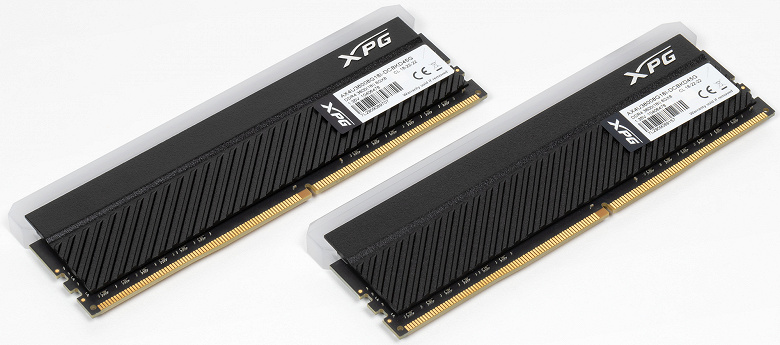
And the top plastic patch includes customizable LEDs. What they are here and how much – the company is silent, so nothing special (which is expected – after all, the modules are relatively inexpensive). There is nothing special to tell about it – four years ago it was a hot novelty, but now it has already set its teeth on edge in such an implementation that … Enough to watch the video.
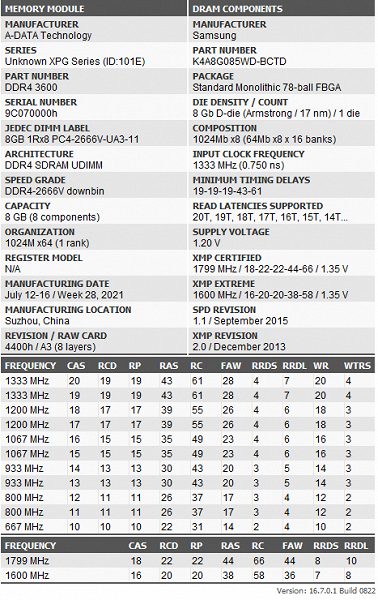
We’d better see what’s inside, for which we’ll use Thaiphoon Burner. We see Samsung D-die – most often these chips are found in OEM modules of Samsung itself, but they also have overclocker modules with frequencies of 4000+ MHz. Yes, they are also in the D45G family. And we can assume that 16 and 32 GB modules are produced on A-die, so it will be bad to overclock above the promised 3600. For 8 GB, there is a considerable chance to get more than the declared one. No other features were found. In addition to one, there are actually two XMP profiles: the “official” 3600 and (optional) 3200, but with reduced latency. Although all this can be configured manually – as well as try higher frequencies.
Why we assembled a test bench based on the Core i7-11700K processor and the MSI MAG M560M Mortar Wi-Fi board. The Mortar line itself is aimed at budget buyers, but with requests slightly above average, it means that today it will suit us perfectly.
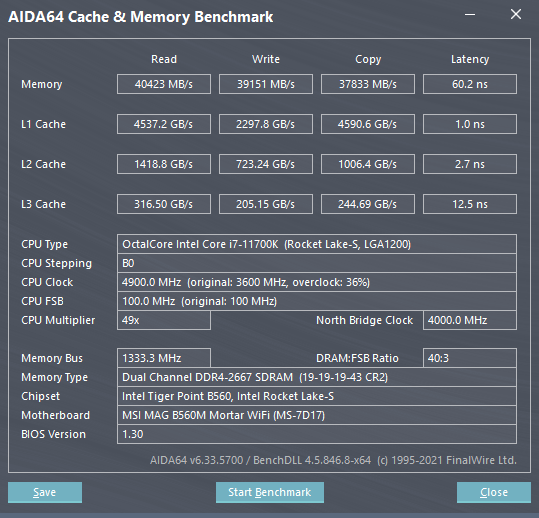
By default, everything starts as DDR4-2666, of course. And it shows the same results as any other memory with such timings.
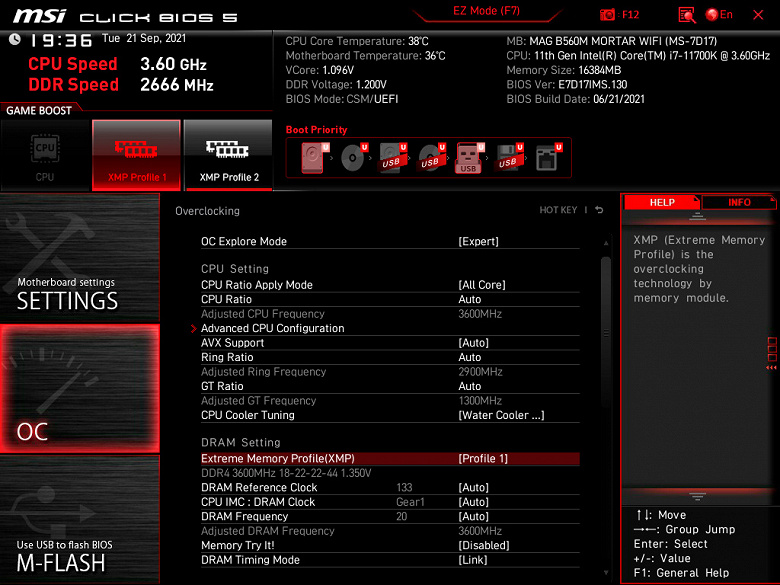
We go to Setup – enable the XMP profile. Sounds ordinary – if you forget that this board is based on a V-chipset 🙂
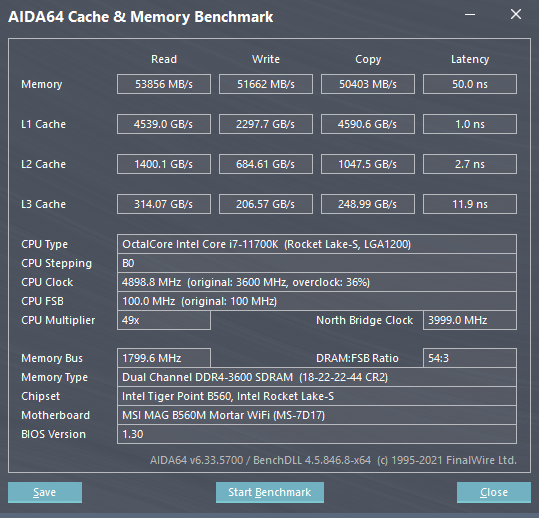
All results in synthetics increase in proportion to the increase in frequency and decrease in absolute delays. So we have to try to move on.
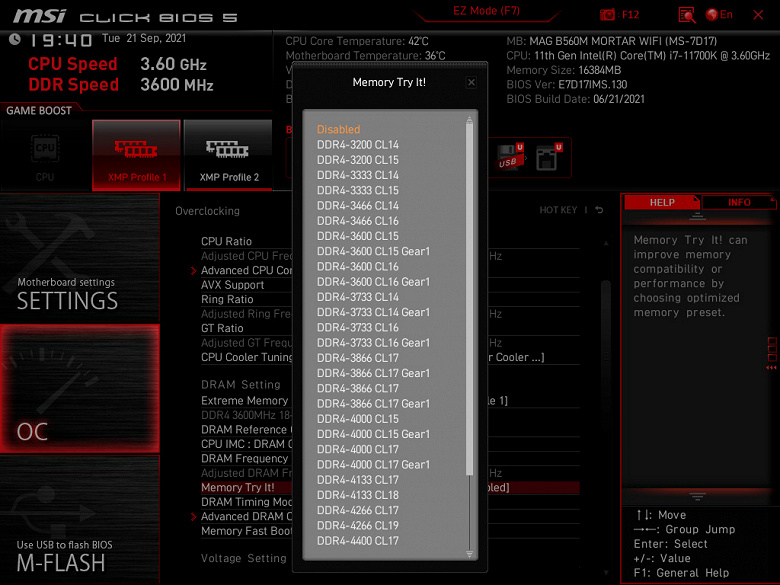
In principle, MSI has a special set of presets hidden under the “Memory Try It!” to make life easier for lazy users. But it is clearly seen that it will not help us today – they are clearly selected for much more “fatty” products. Therefore, we simply leave the relative timings in place, increase the voltage to 1.41 V instead of 1.35 V (in this case, it is still safe ) – and try to set the DDR4-4000 mode.
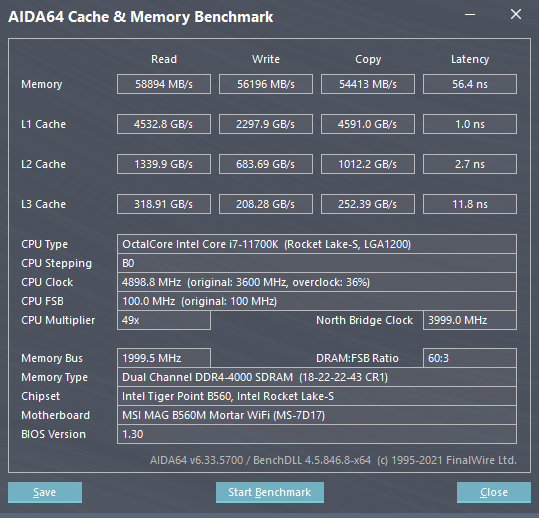
Everything starts quietly, but the results show that the controller switched to Gear2: the delays are lower than at 2666 MHz, but higher than at 3600 MHz.
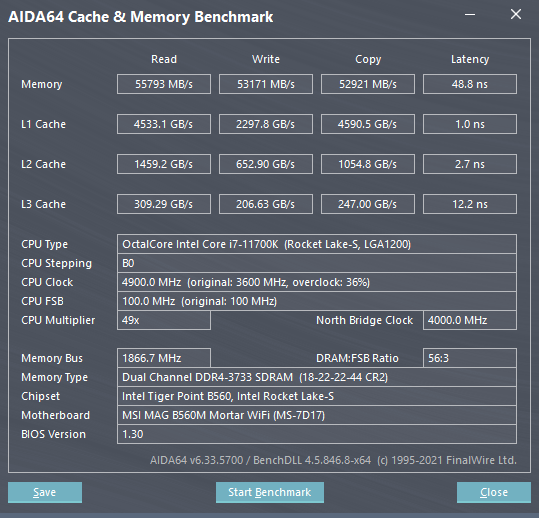
Fixing the controller mode and minor manipulations lead us to the DDR4-3733 mode – where everything is a little better, with the “regular” XMP profile. As expected – in fact, most Rocket Lake processors “withstand” Gear1 exactly up to 3733 MHz inclusive. 3800 or, moreover, higher – if you are very lucky with a copy. And it practically does not depend on the specific memory.
Note that we practically failed to improve both results even when the voltage was increased to 1.45 V. More precisely, we managed to start the system at a frequency of 4133 MHz with the same relative timings, but at least not finish loading to take a screenshot. We could still experiment with timings and voltages, but we considered it inappropriate – it is clear that Adata selects the best modules for kits with official 4133/4400 MHz. This OEM is sometimes useful to sort – in this case, everything is done by the manufacturer. Moreover, work in Gear2 is not interesting from a practical point of view. And the 3733 MHz received in Gear1 also practically do not differ from the declared mode – which is turned on with one button.
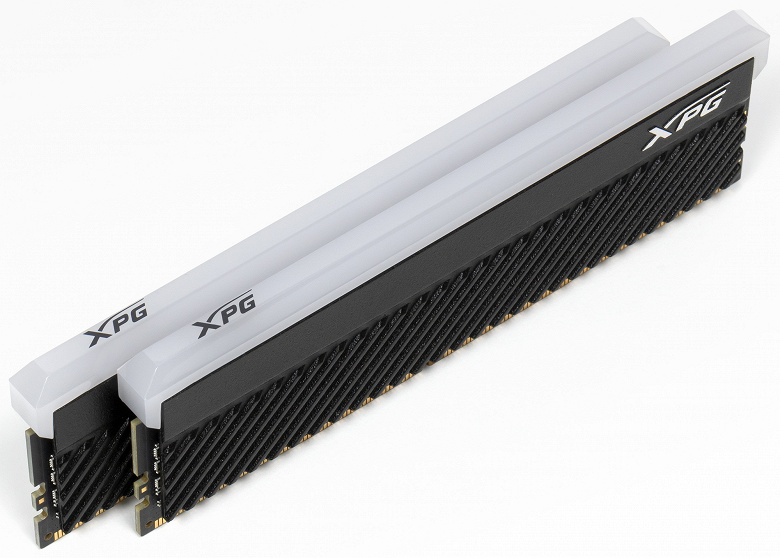
The bottom line is simple: XPG Spectrix D45G RGB memory modules (and dual-module kits) are a good solution for the middle price range, designed for medium (by today’s standards) frequencies. The latter does not interfere in practice, since modern Core controllers (and Ryzen too – before) switch to a slower mode of operation above a certain threshold, so the race for memory frequency can lead to some decrease in performance. And if you just want to get a level slightly higher than the standard one for AMD and Intel processors (there the official maximum is 3200 MHz), and without any difficulties and fine tuning, they will certainly do. Plus nice design and quality workmanship. And the backlight – which, however, can be written not only in pluses, but also in minuses: depending on individual preferences. But in the second case, internally similar XPG Gammix D45 can come to the rescue, since they are also a little cheaper – just due to the rejection of RGB.
In conclusion, we offer you to watch our video review of XPG Spectrix D45G RGB memory modules:
Our video review of XPG Spectrix D45G RGB memory modules can also be viewed at iXBT.video




